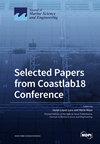用于评估水力参数的修订摩擦力组:压降、流量和直径估算
IF 2.8
3区 地球科学
Q1 ENGINEERING, MARINE
引用次数: 0
摘要
为解决三种典型的水力问题提供了合适的摩擦力组。基于粘性力的摩擦力组用于计算管道和明渠中的压降或水头损失(通常称为水力工程中的第 1 类问题),而具有类似行为的其他摩擦力组则用于计算稳定流排放(第 2 类问题)和估算水力直径(第 3 类问题)。与粘性摩擦组相反,传统的达西-韦斯巴赫摩擦因数与雷诺数呈负相关。因此,在著名的 Moody 图表上,雷诺数从小到大的曲线都是向下倾斜的。相比之下,这里使用的基于粘性力的摩擦力组建立了更合适的关系。在这种情况下,摩擦力和雷诺数呈正相关,即两者同时增大或减小。在此,上述三个问题的重新排列图显示了相似的行为。本文将 Moody 图与粘性摩擦力组图进行了比较。两个图表中的湍流部分都基于 Colebrook 方程,而新的重排版本则使用了粘性摩擦力组。由于 Colebrook 方程在摩擦力方面是隐式的,需要迭代求解,因此为重新制定的版本提供了使用兰伯特 W 函数的显式求解。提供了管道和明渠流动的示例。本文章由计算机程序翻译,如有差异,请以英文原文为准。
Revised Friction Groups for Evaluating Hydraulic Parameters: Pressure Drop, Flow, and Diameter Estimation
Suitable friction groups are provided for solving three typical hydraulic problems. While the friction group based on viscous forces is used for calculating the pressure drop or head loss in pipes and open channels, commonly referred to as the Type 1 problem in hydraulic engineering, additional friction groups with similar behaviors are introduced for calculating steady flow discharge as the Type 2 problem and, for estimating hydraulic diameter as the Type 3 problem. Contrary to the viscous friction group, the traditional Darcy–Weisbach friction factor demonstrates a negative correlation with the Reynolds number. This results in curves that slope downward from small to large Reynolds numbers on the well-known Moody chart. In contrast, the friction group used here, based on viscous forces, establishes a more appropriate relationship. In this case, the friction and Reynolds number are positively correlated, meaning that both increase or decrease simultaneously. Here, rearranged diagrams for all three mentioned problems show similar behaviors. This paper compares the Moody diagram with the diagram for the viscous force friction group. The turbulent parts of both diagrams are based on the Colebrook equation, with the newly reformulated version using the viscous force friction group. As the Colebrook equation is implicit with respect to friction, requiring an iterative solution, an explicit solution using the Lambert W-function for the reformulated version is offered. Examples are provided for both pipes and open channel flow.
求助全文
通过发布文献求助,成功后即可免费获取论文全文。
去求助
来源期刊

Journal of Marine Science and Engineering
Engineering-Ocean Engineering
CiteScore
4.40
自引率
20.70%
发文量
1640
审稿时长
18.09 days
期刊介绍:
Journal of Marine Science and Engineering (JMSE; ISSN 2077-1312) is an international, peer-reviewed open access journal which provides an advanced forum for studies related to marine science and engineering. It publishes reviews, research papers and communications. Our aim is to encourage scientists to publish their experimental and theoretical results in as much detail as possible. There is no restriction on the length of the papers. The full experimental details must be provided so that the results can be reproduced. Electronic files and software regarding the full details of the calculation or experimental procedure, if unable to be published in a normal way, can be deposited as supplementary electronic material.
 求助内容:
求助内容: 应助结果提醒方式:
应助结果提醒方式:


